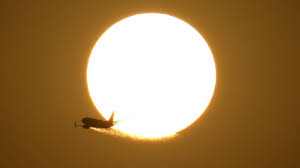As the temperature rises across the country, the anticipation for summer is palpable. While the season has not officially begun, the upcoming summer solstice is already creating a buzz. On Friday, June 20, the Northern Hemisphere will experience the longest day and shortest night of 2025, marking the commencement of summer and the Pagan holiday of Litha, also called Midsummer.
According to the National Weather Service cNWSc, the summer solstice will occur at 10:42 p.m. Eastern Time. This event signifies the Earth's tilt leaning closest to the sun in the Northern Hemisphere, resulting in an extended period of daylight. Conversely, the Southern Hemisphere will embrace winter with its winter solstice during this time.
NASA explains that the summer solstice showcases the Sun's longest and highest arc across the sky for areas north of the equator, emphasizing the Northern Hemisphere's positioning towards the Sun. The moment of the solstice is fleeting, lasting only moments as Earth's northernmost point edges nearer to the sun, allowing for increased sunlight.
The specific date of the summer solstice can vary between June 20 and June 22 each year. In 2024, the solstice occurred on Thursday, June 20. The occasion is celebrated worldwide, with notable gatherings at locations like Newgrange in Ireland and the iconic Stonehenge in England, which has become a significant site for solstice celebrations.
Stonehenge, constructed by an ancient civilization between 3100 and 1600 BC, remains shrouded in mystery regarding its purpose. The monument's alignment with the sun has led to various theories and has made it a focal point for pagan religions, New Age beliefs, and folklore throughout history.
The summer solstice is more than just the longest day of the year; it symbolizes the transition into summer and a period of extended daylight. The significance of the solstice stems from Earth's tilt, about 23.5 degrees off vertical, a characteristic that gives rise to the changing seasons.
In the Bay Area, the summer solstice of 2025 will commence at 7:42 p.m. Pacific Standard Time on Friday, June 20. This celestial event marks the beginning of astronomical summer and offers a unique opportunity for people to appreciate the Earth's intricate orbit and the impact of its tilt on our daily lives.
While many associate the summer solstice with the warmest temperatures, the hottest days often occur after the solstice due to the seasonal lag in Earth's heat absorption. Despite this, the solstice serves as a reminder of the natural cycles and changes in our climate.
Various events and celebrations are planned around the summer solstice, including the Lawrence Hall of Science Summer Solstice Celebration, Paint & Sip at Chabot Space & Science Center, and the Solstice Sea Star Search at California Academy of Sciences. These events provide engaging ways for individuals to connect with nature and immerse themselves in the beauty of the summer solstice.
As we approach this astronomical milestone, let's take a moment to appreciate the wonders of the natural world and the profound impact of the summer solstice on our lives. Whether you choose to observe the solstice quietly or participate in public celebrations, this event serves as a reminder of the Earth's harmonious dance with the Sun and the changing of the seasons.

